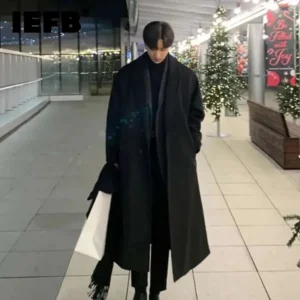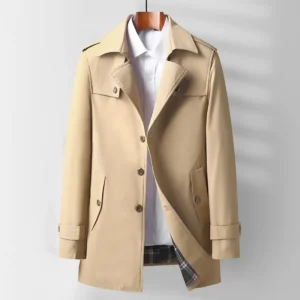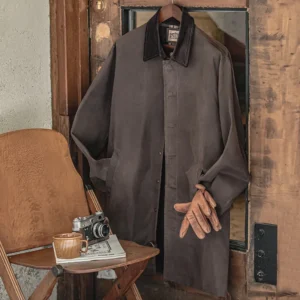The Versatility of Herringbone: Both Formal and Casual
Herringbone is both formal and casual—its versatility allows it to transition seamlessly between refined business settings and relaxed weekend wear. This distinctive pattern has earned its place as one of menswear’s most adaptable elements, appearing in everything from prestigious boardroom suits to comfortable weekend jackets. The formality of herringbone largely depends on several key factors: the fabric type, the garment it appears on, the scale of the pattern, the color palette, and how you style it.
The zigzag weave creates a distinctive texture that adds visual interest without overwhelming an outfit, making it appropriate for numerous contexts. This inherent versatility explains why herringbone remains a perennial favorite among well-dressed men. Understanding the proper coat length for your height significantly impacts how formal or casual your herringbone garment appears.
Throughout menswear history, herringbone has maintained its popularity by adapting to changing fashion standards while retaining its classic appeal. The pattern appears in luxury suits crafted by prestigious tailors and equally in relaxed country clothing. Choosing the right coat length ensures your herringbone garment communicates the appropriate level of formality for any occasion.
This guide will explore how herringbone transitions between formal and casual settings, helping you understand when and how to wear this classic pattern for maximum impact and style. Whether you’re considering investing in a herringbone wool coat or simply want to understand how to style existing pieces in your wardrobe, we’ll cover everything you need to know.
Understanding the Herringbone Pattern
Herringbone is a distinctive V-shaped weaving pattern that resembles the skeleton of a herring fish—hence its name. The pattern consists of rows of parallel lines that slant in opposite directions, creating a broken zigzag effect that distinguishes it from similar patterns like chevron. While chevron forms a continuous zigzag with the lines meeting at exact points, herringbone creates a more staggered, broken effect where the diagonal lines appear to break at the reversal points.
The pattern is created through a specialized twill weave technique where weft threads are woven into the warp threads at regular intervals but in opposite directions, creating its characteristic V-shaped structure. This specific weaving method gives herringbone fabric an inherent texture and visual depth that flat weaves simply cannot achieve.
Most commonly found in wool, cotton, linen, and tweed fabrics, herringbone’s textural quality makes it particularly suited for outerwear and suiting. The herringbone coat pattern creates a subtle visual interest without being overly bold or distracting. The pattern’s texture catches light differently as you move, giving garments a dynamic quality that flat fabrics lack.
This inherent texture and visual complexity enable herringbone to bridge formal and casual contexts effectively. The pattern adds sophistication to casual pieces while simultaneously softening the rigidity of formal attire, making it one of the most versatile patterns in the menswear canon.
Herringbone in Formal Settings: When It Exudes Elegance
Herringbone achieves its most formal expression when rendered in fine, smooth fabrics with a tight, subtle pattern. The refined nature of a well-executed herringbone weave lends sophistication to formal attire while providing subtle visual interest that plain fabrics cannot match. In business and formal settings, herringbone offers a way to incorporate pattern without sacrificing professionalism.
What makes herringbone appropriate for formal occasions? Several characteristics determine its formality level:
- Fine materials: Worsted wool, high-quality cotton, or silk blends with a smooth finish
- Subtle pattern scale: Small, tight herringbone weaves that aren’t immediately noticeable from a distance
- Subdued colors: Dark or neutral tones like charcoal, navy, black, or subtle grays
- Precise tailoring: Clean lines and structured silhouettes that maintain formality
- Minimal texture: Smoother finishes rather than pronounced texture
Formal herringbone commonly appears in these classic pieces:
- Tailored suits in fine worsted wool, particularly in banking and legal professions
- Elegant wool overcoats with structured shoulders and clean lines
- Formal dress shirts with subtle, barely perceptible herringbone weaves
- Silk herringbone ties and pocket squares for refined accessorizing
The most formal herringbone garments use the pattern to add subtle dimension rather than bold visual impact. The pattern should whisper rather than shout, integrating seamlessly into a sophisticated ensemble. When shopping for formal herringbone coats, look for refined tailoring and high-quality materials that signal elegance.
Key Garments: Formal Herringbone Pieces
Suits
The herringbone suit represents one of the pattern’s most formal applications. Typically crafted from fine worsted wool in subtle, dark colorways like charcoal or navy, formal herringbone suits feature tight, small-scale patterns that provide texture without overwhelming the eye. These suits work exceptionally well in professional settings where subtle distinction is appropriate. The pattern adds visual interest while maintaining the formality required for important business meetings or special occasions.
Overcoats
Formal herringbone overcoats have long been a staple of refined winter wardrobes. These distinguished pieces, often constructed from premium wool, feature clean lines, structured shoulders, and precise tailoring. Dark colors like black, charcoal, and navy dominate this category, though lighter grays can also work in formal settings when properly styled. Styling formal coats with suits requires attention to proportion and color coordination to maintain an elegant silhouette.
Dress Shirts
Formal herringbone extends to dress shirts, where the pattern appears in exceedingly subtle implementations. These shirts typically feature very fine herringbone weaves in crisp cotton, sometimes only noticeable upon close inspection. White, light blue, and pale pink herringbone dress shirts pair beautifully with solid suits and ties for professional environments. The subtle texture elevates basic business attire without introducing inappropriate casualness.
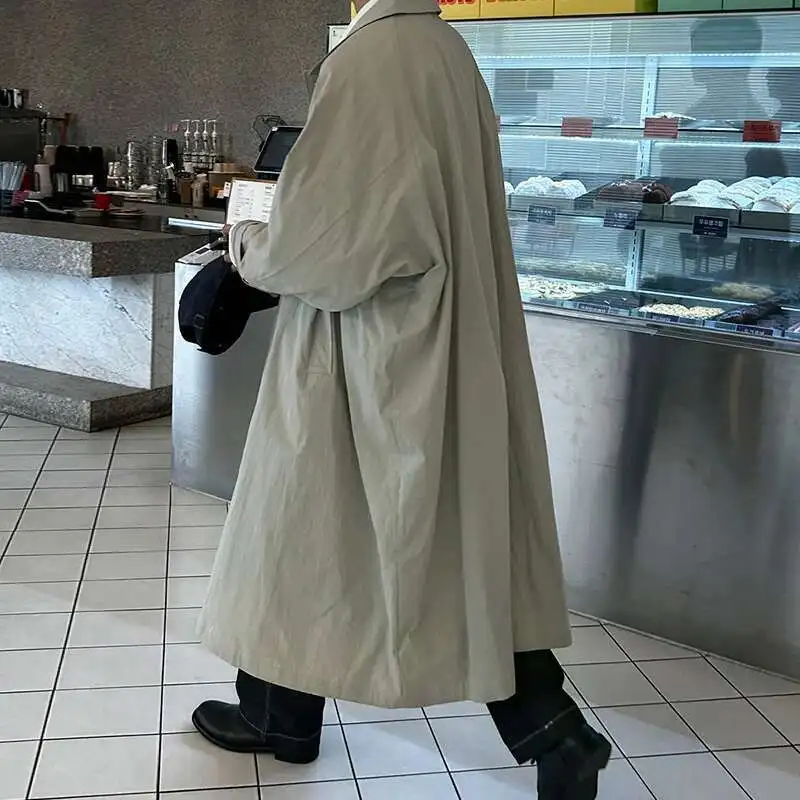
Accessories
Herringbone accessories like silk ties and pocket squares represent the most delicate application of the pattern. These pieces often feature miniature herringbone weaves that add sophistication to formal ensembles. When selecting formal herringbone accessories, opt for refined fabrics and subtle colorways that complement rather than compete with other elements of your outfit.
Herringbone in Casual Wear: Relaxed Sophistication
Herringbone truly shines in casual and business casual contexts, where it adds a touch of refinement to relaxed attire. The pattern’s inherent texture and visual interest make casual pieces more sophisticated without sacrificing comfort or approachability. Understanding the coat length style guidelines helps ensure your casual herringbone outerwear achieves the right proportional balance.
In casual settings, herringbone transforms through several key characteristics:
- Textured materials: Tweed, heavy cotton, flannel, or brushed wool with pronounced texture
- Bolder pattern scale: Larger, more visible herringbone patterns that make a stronger visual statement
- Relaxed colorways: Earth tones, warmer neutrals, and occasionally colorful variations
- Less structured silhouettes: Relaxed fits and softer shoulders that emphasize comfort
- Visible texture: A more pronounced hand-feel and surface interest that invites touch
Casual herringbone styling offers greater freedom for personal expression and creative combinations. The pattern works exceptionally well in fall and winter casual wardrobes, where its texture complements other seasonal fabrics like corduroy, denim, and flannel. For more relaxed settings, consider layering different textures and patterns for a sophisticated casual look that maintains visual cohesion through the herringbone’s ordered pattern.
Seasonal considerations also influence casual herringbone styling. Fall and winter typically welcome heavier tweed and wool variants, while spring and summer call for lighter cotton and linen herringbone in breezier silhouettes and lighter colorways.
Key Garments: Casual Herringbone Essentials
Sport Coats & Blazers
The herringbone sport coat or blazer represents perhaps the most versatile expression of the pattern. Typically crafted from tweed or textured wool, these jackets bridge the gap between formal and casual with remarkable ease. Earth tones like brown, tan, olive, and rusty hues dominate this category, though gray remains a perennial favorite. The texture and visual interest of herringbone make these jackets perfect for smart casual environments, from office settings to weekend social gatherings.
Casual Shirts
Cotton and linen herringbone shirts offer a relaxed yet sophisticated option for casual wardrobes. These shirts typically feature more pronounced patterns than their formal counterparts and come in a wider range of colors. The texture adds visual interest to otherwise simple outfits, making them excellent standalone pieces or layering options. Button-down herringbone shirts in oxford cloth are particularly versatile, working well with jeans, chinos, or even under casual suits.
Trousers
Herringbone trousers in wool, cotton, or blended fabrics provide a smart-casual alternative to plain pants. These typically feature more relaxed cuts and comfortable waistbands suited to everyday wear. Earth tones and neutrals dominate, though seasonal variations might introduce subdued colors. The textural interest makes these trousers perfect partners for solid tops, creating balanced outfits with visual depth.
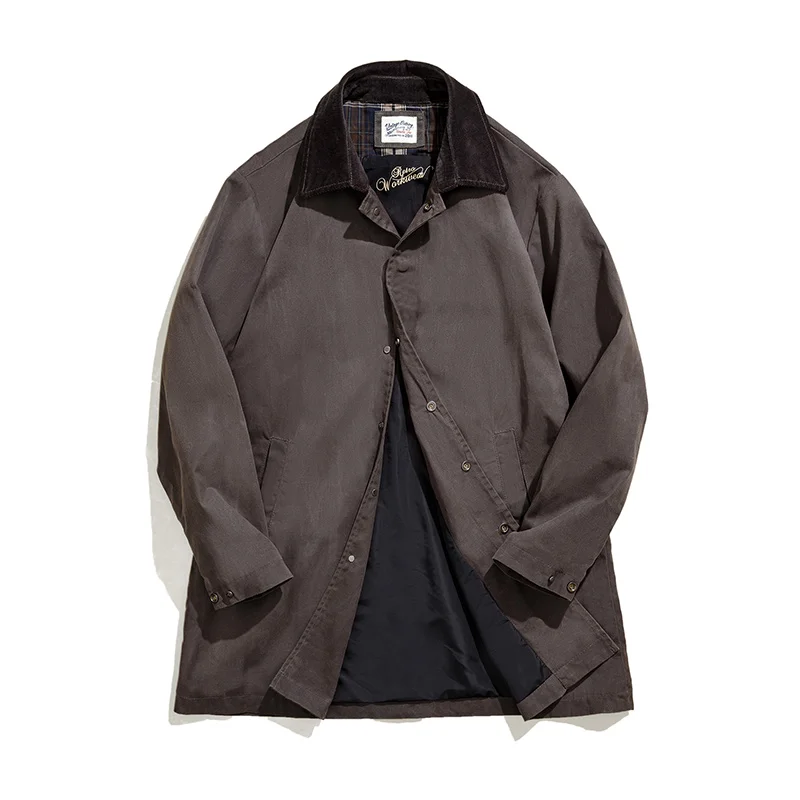
Outerwear
Casual herringbone outerwear spans a wide range of options, from rugged field jackets to relaxed car coats. Tweed coats with herringbone patterns offer exceptional warmth while maintaining a sophisticated country aesthetic. These pieces typically feature more relaxed shoulders, practical pockets, and durable construction suitable for everyday wear. The pattern’s traditional associations make it particularly appropriate for heritage-inspired casual outerwear.
Accessories
Casual herringbone accessories include wool scarves, flat caps, and even backpacks or messenger bags. These items typically feature larger pattern scales and more textured materials than their formal counterparts. Wool herringbone flat caps and newsboy caps have particular historical resonance, connecting to working-class traditions while maintaining contemporary relevance.
Factors That Determine Herringbone’s Formality
Fabric Type
The fabric hosting the herringbone pattern significantly influences its formality level. Fine, smooth worsted wools and silks with minimal texture project formality and refinement, making them appropriate for business and dressy occasions. Conversely, rougher tweeds, heavy cottons, and textured wools with pronounced hand-feel naturally lean casual, evoking country traditions and relaxed settings. The fabric’s weight also plays a role—lighter fabrics typically read more formal than heavier, bulkier options.
Pattern Scale
The size of the herringbone pattern dramatically affects its perceived formality. Smaller, tighter herringbone patterns that aren’t immediately discernible from a distance maintain formal propriety. These subtle implementations add textural interest without drawing undue attention. Larger, more pronounced herringbone patterns make stronger visual statements more suitable for casual contexts. The general rule: the more visible the pattern, the more casual the effect.
Color Selection
Color choices fundamentally influence herringbone’s formality level. Dark, subdued tones like charcoal, navy, and black project maximum formality, making them ideal for business suits and formal overcoats. Mid-range neutrals like gray occupy the middle ground, adaptable to either formal or casual settings depending on styling. Earth tones, particularly browns, tans, and greens, naturally lean more casual, connecting to country traditions and relaxed aesthetics. For comprehensive guidance, explore the best colors for herringbone coats based on your intended level of formality.
Construction & Tailoring
A garment’s construction significantly impacts its formality regardless of pattern. Structured shoulders, canvassed construction, and precise tailoring elevate herringbone to formal status. Conversely, unstructured shoulders, relaxed fits, and casual details like patch pockets or elbow patches firmly place herringbone in casual territory. The Metro Cloak collection of overcoats demonstrates how construction details influence the formality of patterned outerwear.
Styling & Context
Perhaps most importantly, how you style herringbone and where you wear it ultimately determines its formality level. A herringbone sport coat with a dress shirt and tie projects business casual refinement, while the same jacket with a t-shirt and jeans creates a relaxed weekend look. Context matters tremendously—what works for a countryside walk differs from business meeting attire.
Seasonal Considerations for Herringbone
Herringbone adapts remarkably well to different seasons through thoughtful fabric selection and styling. Traditional wool herringbone dominates fall and winter wardrobes, offering warmth and textural interest when layering becomes essential. For cold weather, wool herringbone in medium to heavy weights provides both insulation and sophisticated appearance, particularly in outerwear and suits.
Spring and summer call for lighter interpretations of herringbone. Cotton and linen herringbone in lighter weights offer breathability while maintaining the pattern’s visual appeal. These summer variations typically feature more relaxed construction and lighter colorways, often in tan, light gray, or even pale blue that complement seasonal palettes.
For transitional seasons, mid-weight wool or wool-blend herringbone proves particularly versatile. These fabrics provide moderate warmth without overheating, making them ideal for unpredictable weather. The relationship between herringbone and plaid patterns offers interesting possibilities for seasonal wardrobes, as these patterns often complement each other in transitional outfits.
Color selection should also follow seasonal cues. Darker, richer tones work best in fall and winter, while lighter, airier colors suit spring and summer. This seasonal color alignment ensures herringbone remains appropriate year-round rather than feeling out of place during warmer months.
Expert Styling Tips for Herringbone
Master pattern mixing: Pair herringbone with complementary patterns by varying scale. Combine larger herringbone with smaller patterns like fine pinstripes or subtle dots. Ensure patterns share at least one color for cohesion.
Balance texture effectively: Herringbone’s inherent texture works best when balanced with smoother fabrics. Pair textured herringbone jackets with crisp shirts and smooth trousers to create visual harmony through textural contrast.
Utilize strategic color pairing: Build outfits around herringbone’s colors by pulling out secondary tones from the pattern. Gray herringbone often contains blue or brown undertones that can be echoed in accessories or other garments.
Apply the rule of proportion: Match the herringbone scale to your frame. Larger men can wear more pronounced patterns, while smaller builds benefit from finer herringbone that doesn’t overwhelm their frame.
Create depth through layering: Use herringbone as either a foundation or statement piece within layered outfits. A herringbone overcoat adds sophisticated texture over solid suits, while a herringbone vest or scarf adds visual interest to simpler ensembles.
Mens Cashmere Overcoat, Mens Hooded Winter Coat, Mens Wool Blend Coat
Price range: $128.72 through $139.68 Select options This product has multiple variants. The options may be chosen on the product pageMens Black Overcoat, Mens Black Wool Coat, Mens Wool Overcoat
$339.18 Select options This product has multiple variants. The options may be chosen on the product pageMens Grey Overcoat, Mens Wool Blend Coat, Mens Wool Overcoat
$201.28 Select options This product has multiple variants. The options may be chosen on the product pageMens Herringbone Coat, Mens Long Overcoat, Mens Wool Overcoat
Price range: $197.16 through $203.69 Select options This product has multiple variants. The options may be chosen on the product pageMens Long Overcoat, Mens Topcoats
Price range: $189.40 through $196.88 Select options This product has multiple variants. The options may be chosen on the product pageMens Long Overcoat, Mens Tweed Coat
Price range: $397.49 through $409.96 Select options This product has multiple variants. The options may be chosen on the product page
The timeless appeal of herringbone overcoats derives partly from their styling versatility. They can be dressed up with formal business attire or dressed down with jeans and knitwear, demonstrating the pattern’s remarkable adaptability.
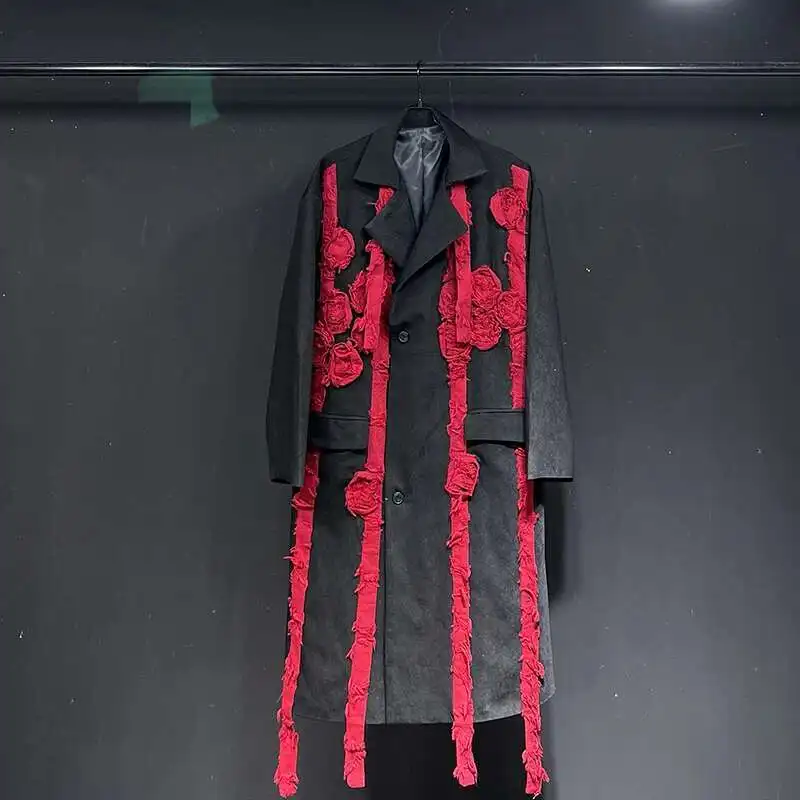
Frequently Asked Questions About Herringbone
Is herringbone appropriate for black-tie events?
Traditional herringbone patterns are generally too casual for true black-tie events, which typically call for solid fabrics. However, extremely subtle, small-scale herringbone in black worsted wool can sometimes work for less strict interpretations of formal dress codes.
How can I tell if my herringbone piece is too casual for work?
Assess the pattern scale, fabric texture, and color. Smaller patterns in smooth, dark fabrics are office-appropriate, while larger patterns in textured, lighter-colored fabrics lean casual. When in doubt, err on the conservative side in professional environments.
Can I mix herringbone with other patterns?
Absolutely. Herringbone pairs beautifully with other patterns when you vary the scale. Combine herringbone with stripes, checks, or dots by ensuring the secondary pattern is of a different size—if your herringbone is bold, keep other patterns subtle, and vice versa.
Does herringbone flatter all body types?
Herringbone can work for all body types when scaled appropriately. Larger individuals should opt for medium to larger scale patterns that proportionally match their frame, while smaller individuals benefit from finer herringbone that doesn’t overwhelm their silhouette.
What’s the difference between herringbone and houndstooth?
Though both are classic patterns, herringbone creates a zigzag effect with broken diagonals, while houndstooth features a more complex, abstract checked pattern resembling jagged or broken checks. Herringbone tends to be more versatile across formality levels.
Why Herringbone Remains a Wardrobe Staple
Herringbone’s enduring popularity stems precisely from its remarkable versatility. Few patterns transition so effortlessly between formal boardrooms and casual weekends, making herringbone pieces particularly valuable investments. Quality herringbone garments often become wardrobe workhorses, serving multiple contexts and occasions with simple styling adjustments.
This adaptability makes herringbone particularly suited to capsule wardrobes and minimalist approaches to dressing. A single herringbone sport coat, for instance, can fulfill numerous roles within a wardrobe, from business casual cornerstone to weekend refinement. The enduring symbolism of herringbone patterns connects wearers to traditions of craftsmanship while maintaining contemporary relevance.
Understanding context remains the key to wearing herringbone appropriately. By considering the specific factors we’ve explored—fabric, pattern scale, color, construction, and styling—you can confidently incorporate this classic pattern into various aspects of your wardrobe, knowing exactly when it reads formal and when it conveys casual sophistication.





